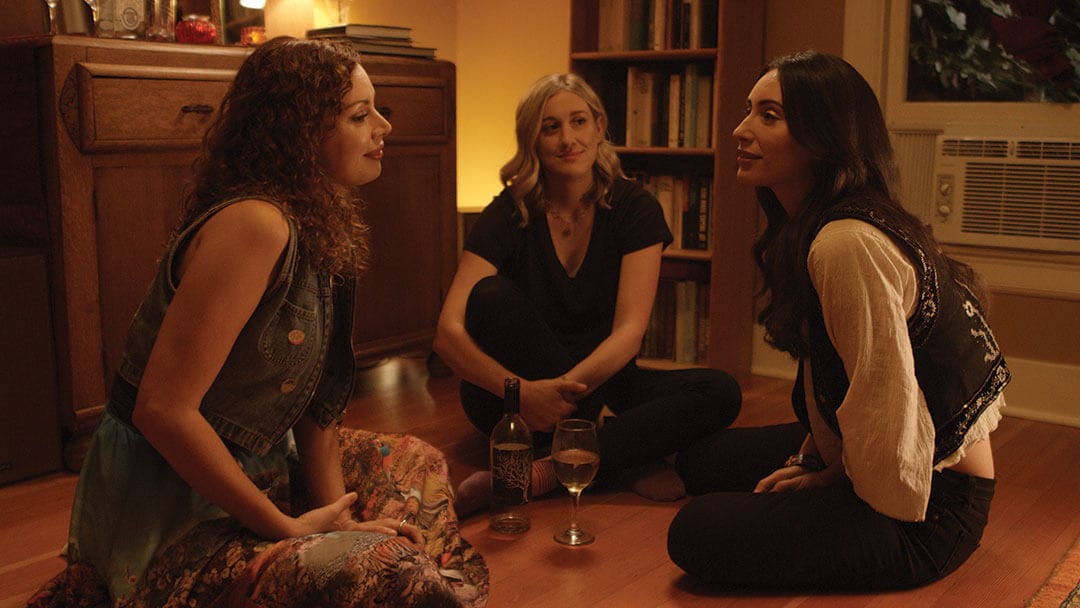When Wendy Jo Carlton set out to create Good Kisser, her latest film, she aspired to create something more than your average lesbian romance movie. She wanted, instead, to tell a story with nuanced and relatable human narratives—one that would have the potential to reveal heavy truths about how relationships work.
Good Kisser takes place over a single night, as Jenna (Kari Alison Hodge) and her girlfriend, Kate (Rachel Paulson), take a taxi over to an acquaintance’s house to have a threesome for the first time. The resulting course of events tests the stability of their relationship and brings to the fore the women’s desires, wants and insecurities. Good Kisser is now streaming online across a variety of platforms.
Xtra spoke to Carlton about women’s sexuality, chemistry between characters, polyamory and her new film.
What inspired you to make Good Kisser?
I wanted to tell the story of three queer women for representation, because I haven’t seen many stories of adult queer women where they are involved in love affairs—and enjoying sex—without the story being politicized. This story isn’t about coming out, and it’s also not about finding “the one.” I know from my own experience that there is much more variety to life than that. I also wanted to portray a lesbian character who’s learning to trust herself and work through her self-esteem issues.
Why did you decide to depict a non-monogamous relationship?
I think it’s something that a lot of people have experienced. It’s important for people to have the right to live their lives and sleep with whom they want to as consenting adults. Even in the queer community, and especially with women, there’s sometimes a sense of fear and shame around polyamory, which I wanted to help remove a bit.
In pop culture, lesbians are frequently stereotyped as either de-sexualized or hyper-sexualized. What was it like to make a movie about lesbian sex within this paradigm?
Women in general tend to be shamed or discouraged from expressing or enjoying sexual attraction and chemistry. But, at the same time, I know that lust is a common experience in many people’s lives. I think it’s powerful within our patriarchal world to keep representing female characters as something other than sexual objects or de-sexualized beings.

Filmmaker Wendy Jo Carlton
Representation of lesbians aligns with these stereotypes because it [often] isn’t lesbian filmmakers creating the characters. Good Kisser is similar to my web series Easy Abby (a rom-com web series about a promiscuous lesbian who struggles with anxiety) in that it comes from the same inspiration: Wanting to write lesbian characters who are unapologetically enjoying sex.
Where does the inspiration for your characters come from?
A lot of inspiration for my characters comes from my own love life and my own observations of other people’s lives and love lives. I don’t personally have a history of long-term polyamory, but I do have a history of falling in love and enjoying acting on my instincts and my attractions.
I’ve not been one to think in my adult life that there’s only one person for me. I like having a special person in my life, but the idea that everyone is supposed to be monogamous is unrealistic, oppressive and certainly not life-affirming.
In Good Kisser, non-monogamy is depicted as a bit more complicated and less idealistic than it might be thought of a lot of the time. When navigating the threesome, the characters struggle with their insecurities, anxieties and personal boundaries. What was behind this?
“I think it’s powerful within our patriarchal world represent female characters as something other than sexual objects or de-sexualized beings”
As a writer, it’s important for me to create nuanced portrayals of any character I’m writing. If you look at some of my other work, there are complicated relationships or people whose moods, actions and motivations shift throughout the story.
In Good Kisser, I’m not really trying to represent polyamory. I’m just trying to portray the particular dynamic of these particular women on this particular night. I wanted to show a relationship that’s not very balanced in terms of consistent mutual respect, because we all take turns being selfish jerks sometimes. We meet this couple at that juncture—when this tension could either bring them closer or not—and we get to watch that play out.
Throughout the film there are a number of lingering shots of hands. What’s the deal with lesbians and hands?
I got my start in photography, and I shot all of my own earlier short films. So I tend to like close-ups, and hands are the next best thing to a human face. Hands are intimate and personal; everyone’s hands are just a little bit different. I’m attracted to hands, and I find that some people tend to just have strong, sexy hands.
What was your favourite thing—or some of your favourite things—about making Good Kisser?
Being able to pull it off. It’s so difficult to make a quality feature film, technically, creatively and logistically—let alone financially, when you’re an independent and your budget is very small. It’s a huge collaborative accomplishment with the cast, the director of photography and my producers.
“I’m more inspired by trying to successfully create emotionally complicated human beings who are gay, lesbian or queer”
Within the story, the chemistry of the characters is my favourite part. Finding the right cast wasn’t easy, knowing it’s super important that their chemistry be believable and enjoyable to watch. Without giving too much away, I loved figuring out how to shoot the dance scene. That scene really captures the flirtatious feeling of bonding with someone that you’re attracted to.
What are you looking to do after this film?
I have two more features that are looking for funding. One is a film called Slipknot, about a middle-aged queer woman who’s a musician and how she deals with suddenly becoming homeless when her girlfriend dies. A slipknot is a kind of knot that’s holding securely, but also keeps moving up and down as needed—to me, it embodies security and danger together.
The other one is called Yellow Belt, and it’s about a female scientist who accidentally discovers that a big, multinational corporation is polluting the Arctic Ocean. She has proof, but her bag is stolen with the evidence inside it. She’s someone who has a history of fucking up: The title comes from how she tried to take a martial arts class but was kicked out after achieving only a yellow belt, a very low level.
As an LGBTQ2 cultural creator, there’s this pressure to speak for a community in general. Does this bother you?
I’m more inspired by trying to successfully create emotionally complicated human beings who are gay, lesbian or queer. I like nuance and I like there to be a variety of human stories in my work. As a filmmaker, I see myself as someone who creates relatable human stories that feature queer leads. I know my life is different because I’m a lesbian woman in this culture—but I also know that we have a lot of similarities as human beings on this planet, and I try to hold on to both ideas simultaneously.
Interview has been edited for length and clarity.


 Why you can trust Xtra
Why you can trust Xtra


